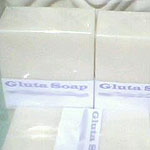
Here are The Materials You Need To Get Started:
60 ml titanium dioxide
60 ml sodium silicate
3 ml anti-bacterial liquid
3 ml preservative (phenoxy ethanol)
60 ml moisturizer (castor oil)
60 ml cocodiethanolamide (CDEA)
60 ml kamias extract (Averrhoa bilimbi)
3.2 L lye solution (caustic soda)
60 ml evaporated milk
6 kg coconut oil (cooking oil)
12 pcs glutathione capsules
100 ml fragrance
60 ml apple extract
4 L distilled water
Since titanium dioxide and caustic soda are sold in powder form, you need to dissolve them in water to come up with the required solution. Specifically, you need to dissolve 60 grams of titanium dioxide in 1 5L- of water, and 1 kilo of caustic soda in 2 5L of water. Although you can also use tap water, it is advisable to use distilled water to prevent contamination. You can produce the kamias extract by fermenting 1 kilo of the balimbi fruit (known locally as kamias) in a jar with 2 tablespoons of salt. After 24 hours, get the extract, strain it and transfer it to another container. You can now use the extract.
To produce the apple extract, cut up one apple and use a blender to crush it. Strain the extract using a piece of cheesecloth to remove impurities. Once you have measured the ingredients, put them in individual containers and label them properly. Since it is the base material for the soap, you may pour the coconut oil into the pail directly.
Remove the glutathione powder from the capsules, then mix it with the coconut oil until the powder is fully dissolved. Pour the following ingredients into the mix in the following order: sodium silicate, CDEA, moisturizer, kamias extract, apple extract, milk, titanium dioxide, preservative, the antibacterial liquid and the fragrance. If the ingredients are not added in this order, the texture of the soap will be rough. Mix the ingredients well with a hand mixer.
Gradually pour the lye solution into the mixture, mixing continuously in one direction. Changing the direction when mixing will create swirls or a cloudy effect on the soap. After adding the lye solution, you will notice a change in the color and consistency of the mixture. Continue mixing until the consistency becomes like that of condensed milk, the mixture gets finer as you continue to mix. Make sure to mix the mixture well enough, otherwise, the soap will feel rough and itchy on the skin. Now pour the mixture into the mold. Before using the mold, make sure that its hollow part is covered with a plastic sheet so the soap will not suck to the mold and can easily be removed from it.
Using a scraper, level and smoothen the top portion of the soap. Once it becomes smooth, set it aside for five hours to cure. After some time, you will notice changes in the color of the soap. Heat will also be released by the soap. These are both signs that the soap is hardening. Even if the soap has already hardened after five hours, don’t remove it from the mold until the following day, when it has really cooled down. Once cool, cut the long bar into approximately 60 pieces. Smoothen the edges of the soap. Use the soap only after 24 hours.
Glutathione herbal soap remains in the best condition for use from 1 to 1 5 years. According to Aveno, herbal soaps that are eight months to a year old are very well cured and so are better to use. After about a year, because the extracts drip in the form of moisture, herbal soaps shrank by some 5 grams Chemical-based soaps, because they use preservatives, may remain hard and last longer.
To package the soap, wrap it in clear plastic and label it properly. To attract more people to buy the soap, state in the label its key ingredients. The price of a 130g bar of glutathione herbal soap in the market ranges from P100 to P200. While you may use this price range to sell individual bars, you may opt to lower the price for wholesale buyers.
Since the most important ingredients in this soap is glutathione, be careful of buying the right kind because just last month there were news about the selling of glutathione capsule containing very little amount of the said ingredients or fall short of the exact amount specified on their packaging and labels. It also doesn’t mean that if the glutathione capsules sold in the market is expensive that it is already genuine. There are some brands that cost so much but when it was analyzed in the laboratory, the glutathione content lacks the specified amount on their packaging.
Where to get the supplies:
ESF Cake and Bread House
2/F Emer Bldg., 13 Rizal Avenue Extension, Kalookan City
Landline: (02) 948-6112
Mobile: 0902-6566943
Source: entrepreneur magazine




Hello sir. Any substitute for kamias fruit?
Hello maam. What is the substitute of kamias extract if it is not available?
Looking forward to your response.
Thanks.
Hello po gusto ko pong gumawa ng papaya soap saan po ba maka bili ng mga sangkap nito? Saan po ba ito sa Cagayan de oro maka bili ng mga sangkap ng homemade soap? gusto ko po kasing mag karoon ng pangkabuhayan. Salamat po
Hi, Good day! can you pls. teach me how to make papaya whitening soap. I am planning to make a small business since I am a full time mom. it will be a big help for me Thanks in advance!
Hello Sir, first Thank you for sharing your knowledge on how to do gluta soap, can I request for the papaya soap recipe and procedure Thanks more power!
Hi there Good day:)
are you also selling kojic acid? How many grams po needed sa 6 pounds ? Thank you much 🙂
How much po ang starting capital ng soap making.im interested in soap making.
Hi, good day! Tanong ko lang po sana kung saan at magkano ang capital for soap making business? I am very interested at willing matuto kung paano magsimula sa ganitong uri ng negosyo.
Sa California po ako pano po pag gusto ko po mag order ng materials pano po ang transactions and shipping?
hi pano po pag sa ibang bansa pa ang magoorder ng mga materials pano po and setup?
For your Materials like caustic soda, Soap Mold Please contact me or
visit http://bft.happy.ph/products/wood-soap-molder
just wanna ask the exact amount of the raw materials? and where to buy the said materials? i live outside manila im here in the province what would be the arrangement please email me at [email protected] thanks and more power!
good day! just wanna ask how much is the cost of all raw materials needed in making glutathione soap?
thanks.
i am very much interested this kind of business and i want to learn how to make soap. pls email me where to buy the exact materials for making this soap and how much should i prepare so i can buy the said materials
how can I get the raw materials kojic soap?? please send to my email [email protected]. be whether it is sent to Indonesia?
can u send me email regarding the list of your raw materials on soap making do you do seminars on soap making if how much thank u
Hi Veng! We conduct soap making tutorial
Here’s my number 09109162828
hi, thanks a lot for ol the info on bath soap making..where can i find or buy moulders near my place pasig city?
For you all Soaps manufacturing needs
+923333367607
[email protected]
We are manufacturer of all kind of Chemicals.
We sale the correct formula and Practical experiment after sale for our valued customer.
Contact us: +923333367607
or send mail to: [email protected]
Regards,
Niazi
hi san kaya ako pwede bumili ng recipe for bodybutter naman thanks…=)
what would be the difference kaya ng glutha soap n binibili sa store nd ung gagawin at home? mas effective b
Hi Gracechelle, for me ma’s maganda kung ikaw mismo ang gumawa ng gluta soap mo kasi pwede no yan gawin na loaded ng gluta and other whitening materials.
Nag tuturo po kami paano gumawa ng effective na sabon since 2009. Tutorial po 🙂
Here’s my # 09109162828
need to inquire about kojic soap making..thanks
Hi Melany! Nagtuturo po ako paano gumawa ng sabon. My # 09109162828
It is the best blog I have read today! I enjoyed reading your blog and I hope you can post more about other beneficial glutathione strategies.
I really like how you brought this concept!
I also got a site that would probably blow you guys! check it.
thank you po 🙂 🙂
july 22, 2009
you can buy chemicals somewhere in Q.C and in Makati. send me your contact nos.
can I make the capital only 2000 pesos just for experimental purposes coz I always makes mistakes on the first try.
and also.. how many bars will 8k make?
how many days before you see the lightening effect of the soap?
can i add more capsules of glutathione.
do you know how to also make kojic and rose hips soaps? like making it 3 in 1? thanks. thanks so much 🙂
( i got so many questions … thanks for being patient with me)
@jacky
The 8k was recommended for buying utensils and the raw materials. Approximately 60 bars is made with 8k and includes the utensils. But if you will only consider the raw materials cost, it is less than 8k, probably 6k.
Hi Jacky! Yes 2000.00 can make 50 PCs of soap
Nagtuturo po ako paano gumawa ng gluta and other soaps variant.
Here’s my # 09109162828
gud eve po paano po ba mag gawa ng gluthatione face and body wash at gluthatione face toner? at saan mabibili ang mga raw mats? tnx po
@joey m. aguillon
Sorry I don’t have an info on making gluthatione face and body wash, gluthatione face toner. I don’t endorse this person but you can try to contact the supplier for details:
Leng Aveno
ESF Cakes and Bread House
2/F Emer Bldg., 13 Rizal Ave. Ext., Kalookan City
Land Line: (02) 948-6112
Mobile: 0920-6566943
gud eve po about sa skin care products po like, face cream,toner, etc kailangan po ba ng bfad or dti lng kung ikaw mismo mag gawa ng products?
hello
can I ask how much is your minimum capital ?
thanks again 🙂
@jacky
@joey m. aguillon
The capital is more or less 8,000 pesos.
@joey m. aguillon
I don’t endorse the commenters but you can call the above comments by Hans and Joel Ng.
pwede po ba na bumili ng by ml na raw materials sa pag gawa ng glutathone soap?
For your chemicals needs & concern:
0921-9842483
(02) 871-0059
(075) 5312053
We sell raw mats in 250g, 500g, 1kg, 5kg….
(Para sa mga nais magnegosyo sa paggawa ng sabon na maliit ang puhunan)
mabibili ba ang mga gamit pang gawa ng glutathione soap sa nag bebenta ng mga raw materials? mag kano kaya mababayaran sa lahat ng gamit at sa mga raw materials ng pag gawa ng glutathione soap? magkano capital sa unahang paggawa ng glutathione soap?
if u need chemiclas for making powder detergent or dishwashing liquid etc. Pls call 5832235 or 09175393306 look for joel ng
I am interested in a printing business. Can you teach on how to start this business. Do I have to register this business in the BIR? Kindly give me some brief knowledge to put up a small business.
@morie
Actually you don’t need to register it if you were just starting. After you already established it, first you need to register your business name to the DTI (Department of Trade and Industry), then get the Mayor’s permit.
paano po ba makasali sa negosyong it? saan po tayo mak kuha ng raw materials?
For your chemical needs, call or text 0929-3133957…
mgkano po lhat mgagastos sa pg gawa ng soap?lht2 po?
can you send mi articles about you feature on Kabuhayan Swak na Swak about miracle tree. somebody told mi about it and i am very interested
hello elmer,
See post above, on the bottom.
Can u pls. email me the place to buy this ingredients, a one stop shop if possible. Ty! God bless!